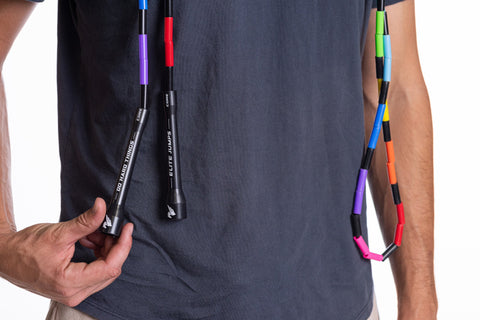Why are Beaded Jump Ropes Best for Beginners?
Sep 16, 2024Janaína Conceição

Choosing the right jump rope can make a huge difference, especially for beginners. Our recent research, commissioned through the Exercise Physiology Lab at Western Kentucky University, reveals why beaded ropes stand out as an excellent choice for newcomers. By analyzing various types of jump ropes, we discovered how beaded ropes—compared to PVC, weighted, and speed ropes—offer unique benefits that can help beginners develop their skills, maintain consistency, and build effective workout habits.
Beaded jump ropes are specifically designed to assist beginners in learning the basics of jumping rope. Unlike other types of ropes, their structure provides distinct advantages that make them particularly suited for those just starting out.
The data showed new jumpers simply “miss” (make a mistake that stops the rope) less with a beaded rope compared to other types of jump ropes. Why? We don’t know exactly, but our theory is that the beads provide natural feedback through the “tick tick” of the rope hitting the ground and the weight of the rope. This feedback helps jumpers know where the rope is in relation to their jump.
Basically, a beaded rope helps beginners feel the movement, leading to fewer missed jumps and faster mastery of technique.
Jump rope beads are about 8mm in diameter, while the thickest PVC and speed ropes are 6mm in diameter. This increased thickness adds wind resistance for a more strenuous workout, making beaded ropes ideal for high-intensity, anaerobic workouts focused on building strength and power.
The research found that, of all the ropes tested, beaded ropes produced the fastest increase in anaerobic contribution to energy expenditure. This shows that beaded ropes provide a high intensity exercise stimulus, making them ideal tools for HIIT training and supramaximal intensity training.
The data showed beaded ropes are the best for HIIT (High-Intensity Interval Training) workouts. If you plan to use a jump rope as part of a circuit, use the beaded rope. The increased resistance forces your muscles to work harder, which enhances the overall intensity of your workout.

The increased drag caused by the beads forces your body to work harder, likely resulting in supramaximal intensity efforts (i.e., exercising at an intensity beyond what the aerobic system can handle). This very high-intensity training can be highly effective for improving fitness and performance variables. For example, research from 2017 shows that supramaximal intensity exercise is more efficient for improving VO2max and anaerobic power output compared to submaximal HIIT training.
Building a consistent exercise routine can be challenging, especially when starting out. Beaded ropes can help you establish a regular workout habit by providing clear feedback and a sense of achievement as you master the technique and increase your jumping duration.
While beaded ropes are ideal for many beginners, speed ropes offer their own set of benefits that may suit different fitness goals.
Speed ropes are designed for quick, smooth rotations, making them perfect for challenging your aerobic system. They help improve your cardiovascular fitness by keeping your heart rate elevated at an intensity that can likely be sustained for longer sessions of steady-state training.
For those who prefer a steady-state workout, speed ropes are a great choice. They allow you to maintain a consistent pace over a longer duration, which is beneficial for endurance training and overall fitness.
Speed ropes are well suited for submaximal training, where the focus is on sustained, moderate-intensity effort. This type of training helps improve endurance and stamina, making speed ropes a good option for those looking to build long-lasting fitness.
When choosing between beaded and speed ropes, consider your fitness goals and preferences. Beaded ropes are ideal for beginners who want to focus on mastering their technique, building strength, and engaging in high-intensity training. On the other hand, speed ropes are better suited for those who aim to improve cardiovascular fitness and endurance through steady-state and submaximal workouts.
In summary, beaded jump ropes offer a range of benefits that make them an excellent starting point for beginners. They help reduce mistakes, build consistency, and challenge your anaerobic system effectively. However, speed ropes also have their advantages for aerobic and endurance training. Ultimately, the best choice depends on your personal fitness goals and preferences.
For more information on selecting the right jump ropes for beginners, check out our article on the 3 Best Jump Ropes for Beginners. To find the ideal rope for your needs, explore our Elite Jumps collection today!
 |
Edited by Kaylee WoodardKaylee Woodard is a jump rope educator and performer with a Master’s degree in Exercise Science and a Ph.D. in Motor Behavior and Sport Psychology. A former competitive jumper, she has won multiple national and world jump rope titles. She now travels the world teaching jump rope with her husband, Nick, through Learnin' the Ropes. |
Sources:
Paquette, M., Le Blanc, O., Lucas, S. J. E., Thibault, G., Bailey, D. M., & Brassard, P. (2017). Effects of submaximal and supramaximal interval training on determinants of endurance performance in endurance athletes. Scandinavian Journal of Medicine & Science in Sports, 27(3), 318-326.
We're all about equipping and encouraging people to take on big challenges, because we know the process of doing hard things helps us grow in character and capacity.
Frequently bought together
You may also like
0 Comments
There are no comments for this article. Be the first one to leave a message!